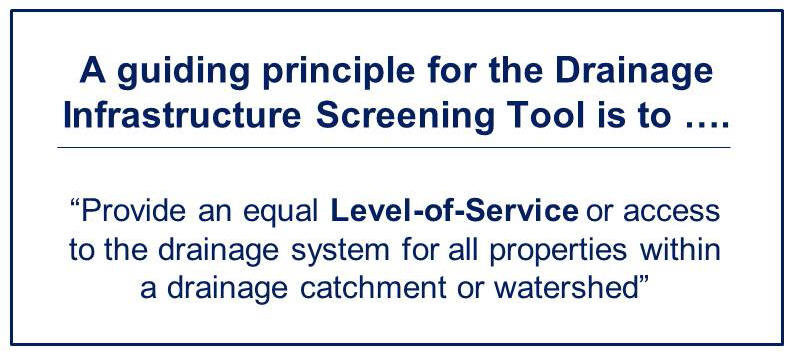Drainage Infrastructure Screening Tool: A Web-Based Application of Common-Sense Engineering
Note to Reader:
The Regional Adaptation Collaboratives (RAC), a federal-provincial program, supports coordinated action towards advancing regional climate change adaptation decision-making by local government. RAC funded development of the Drainage Infrastructure Screening Tool. The tool is web-based and can be accessed only from the Water Balance Model website. The Hastings Creek Blueprint is the first validation application.
How We Look At Drainage Systems
“Experience shows that many systems operate without serious problems for many years. Also, the vast majority of the time, the system capacity is only partially utilized for drainage conveyance,” observes Ted van derGulik, Chair of the Water Balance Model Partnership.
 “Yet many engineering studies recommend plans for pipe replacement and upsizing that would cost tens of millions of dollars, money that local governments do not have; while providing no offsetting stream health benefits.
“Yet many engineering studies recommend plans for pipe replacement and upsizing that would cost tens of millions of dollars, money that local governments do not have; while providing no offsetting stream health benefits.
“The need by our Partners for a new tool spurred development of the Drainage Infrastructure Screening Tool. Now, local governments can focus on what is most important AND save money.”
Focus On What is Most Important
“Based on detailed modelling experience, we know that ‘problems’ fall within a narrow range. The lesson learned is that one need not model  every section of pipe. The level-of-service approach is inexpensive and provides relevant information. It does this without the detailed and expensive simulation of the drainage system,” explains Jim Dumont, Engineering Applications Authority for the Water Balance Model Partnership, and technical advisor to the District. He developed the level-of-service methodology for the screening tool.
every section of pipe. The level-of-service approach is inexpensive and provides relevant information. It does this without the detailed and expensive simulation of the drainage system,” explains Jim Dumont, Engineering Applications Authority for the Water Balance Model Partnership, and technical advisor to the District. He developed the level-of-service methodology for the screening tool.
Ask Four Questions
Four questions provided the decision framework for application of the Drainage Infrastructure Screening Tool to evaluate the adequacy of storm sewer systems draining into Hastings Creek:
- What is the existing level of drainage service within each tributary catchment?
- What will be the effect of climate change?
- What will be the effect of redevelopment?
- How will climate change affect redevelopment?
 “Good engineering is all about knowing when and how to ask the right questions before diving into technical analyses,” reflects Ariel Estrada, Project Engineer for drainage infrastructure, and co-leader for the Hastings Creek Watershed Project. “Having a clear decision framework got us off to a good start and kept us on track. Because a level-of-service approach is actually common-sense engineering, everything fell into place.”
“Good engineering is all about knowing when and how to ask the right questions before diving into technical analyses,” reflects Ariel Estrada, Project Engineer for drainage infrastructure, and co-leader for the Hastings Creek Watershed Project. “Having a clear decision framework got us off to a good start and kept us on track. Because a level-of-service approach is actually common-sense engineering, everything fell into place.”
Validation of Level-of-Service Methodology
“Because we were hands-on, we learned a lot and understand how pipes in the Hastings Creek drainage area perform,” continues Ariel Estrada. “This outcome contrasts with the typical situation when a municipality hires a consultant to build a detailed and expensive computer model. After a period of time, we will receive a report. The model is a black box. From our municipal perspective, we often have little feel for what has been done.”
 “The Hastings Creek process has demonstrated the immediate payback of a small investment in applying the Screening Tool. The District has saved money, both now and in the future, and avoided the pitfalls that other municipalities have experienced,” concludes Richard Boase, co-leader for the Hastings Creek Watershed Project.
“The Hastings Creek process has demonstrated the immediate payback of a small investment in applying the Screening Tool. The District has saved money, both now and in the future, and avoided the pitfalls that other municipalities have experienced,” concludes Richard Boase, co-leader for the Hastings Creek Watershed Project.
To Learn More:
To read the complete story as described in Section 6 of “A Watershed Blueprint for Hastings Creek”, click on Drainage Infrastructure Screening Tool.


